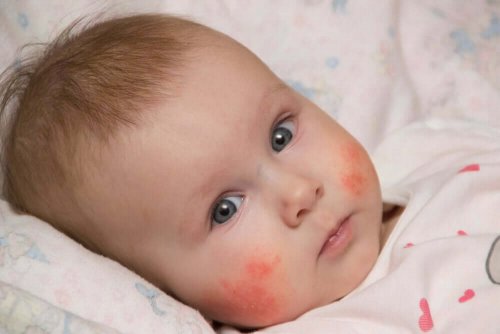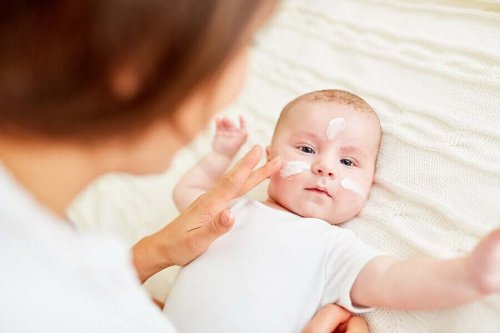Basic Care for Atopic Dermatitis in Babies

Atopic dermatitis in babies is one of the most frequent skin conditions to appear during a baby’s first months of life. Given that it’s a chronic disease, prevention should the main care as well as the relief of the symptoms it presents itself with. Early detection of this dermatological condition will help family members in their task of reducing the symptoms and discomfort it brings about.
What’s atopic dermatitis in babies?
Atopic dermatitis usually begins between their third and fifth month of life. At this stage, their skin lesions typically become more frequent. They usually take place in the form of outbreaks that last about six weeks, although they may just linger.
Atopic dermatitis is an inflammatory skin condition that manifests as dry skin, one of its most significant symptoms. It usually presents itself together with intense itching.
The condition usually remains active until the age of two, and then it either stays longer or disappears entirely. This is a childhood disease with a certain inherited component. For that reason, you must consider your family history.
Read also: How to Treat Herpes in Children
When to consult your pediatrician

Atopic dermatitis doesn’t have specific characteristics. It varies from individual to individual. Therefore, it’s very difficult to differentiate it from other forms of dermatitis. Only a pediatrician can diagnose atopic dermatitis after assessing the symptoms of your baby.
So, you must consult your pediatrician if you observe any of the following on your baby:
- Nonspecific rashes, especially in their facial region and in the flexural areas.
- Rashes that stay for a while.
- Frequent crying, as it may be due to itching discomfort in the affected areas.
How to detect atopic dermatitis
Atopic dermatitis can manifest in different ways. The most common are those we’ll mention here.
Rashes usually appear on the cheeks, forehead, ears, and scalp. Then, they may subsequently extend to the rest of the body, beginning at the facial region. These are usually itchy eczemas and, sometimes, a certain degree of exudation.
Also, atopic dermatitis may present itself with an egg white protein allergy. For this reason, allergy tests must be performed to diagnose an infant.
You may be interested: Should You Wake Your Baby to Change Their Diaper?
How to prevent atopic dermatitis in your baby

To care for atopic dermatitis, family members need proper health education:
- Wash your baby’s clothes with mild detergents and avoid fabric softener.
- Avoid heat, especially hot air. To do so, you must eliminate any woolen fabrics, plastics and some fibers that promote the appearance of sweat and, with it, rashes. Instead, stick to using cotton only.
- Use humidifiers for environmental dryness in regions where humidity levels are too low.
- Perform proper baby hygiene with short baths or showers, no more than 2-3 times a week. This is because excess water and exposure to gels promote the appearance of rashes. Doctors recommend using acidic pH gel or oatmeal.
- Apply moisturizing creams that are made for babies several times a day with a gentle massage so it properly penetrates the skin.
Medical treatment
There are situations in which the symptoms that comprise atopic dermatitis in babies might require pharmacological treatments and monitoring by a physician to prevent complications:
- It’s necessary to consult a pediatrician to determine the pattern of topical anti-inflammatory treatment when there are outbreaks. Also, you must eliminate the emollient lotions you used during the prevention phase.
- Prevent the appearance of skin infections. These usually appear due to scratching after itching begins. Also, you must maintain proper hygiene.
If the pediatrician thinks there may be an infection. then they may prescribe the application of topical or systemic antibiotics.
Topical corticosteroids are some of the most prescribed drugs for this condition by pediatricians. You shouldn’t be afraid to use them, as long as you do so correctly. They provide many benefits for babies with dermatitis.
All cited sources were thoroughly reviewed by our team to ensure their quality, reliability, currency, and validity. The bibliography of this article was considered reliable and of academic or scientific accuracy.
- Capdevila, E. F. (2002). Dermatitis atópica. https://www.aeped.es/sites/default/files/documentos/dermatopica.pdf
- Cáceres, H., & Rueda, M. (1999). Dermatitis atópica. Dermatología Peruana, 9(2), 24-31. https://algoritmos.aepap.org/adjuntos/dermatitis_atopica.pdf
- Urueña, I. C., Vázquez, C. D., Garcinuño, A. C., Merino, A. G., Bernabé, J. M., Pérez, J. P., … & de Phadiatop, G. D. E. A. (2010, January). Perfil de sensibilización alérgica en niños de 0 a 5 años con sibilancias o dermatitis atópica. In Anales de Pediatría (Vol. 72, No. 1, pp. 30-41). Elsevier Doyma. https://www.analesdepediatria.org/es-perfil-sensibilizacion-alergica-ninos-0-articulo-S169540330900592X
This text is provided for informational purposes only and does not replace consultation with a professional. If in doubt, consult your specialist.









